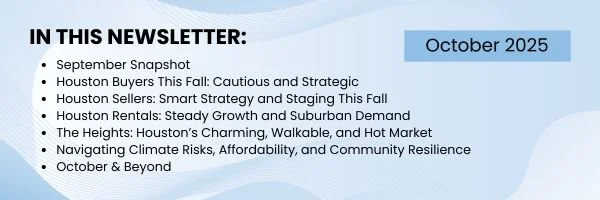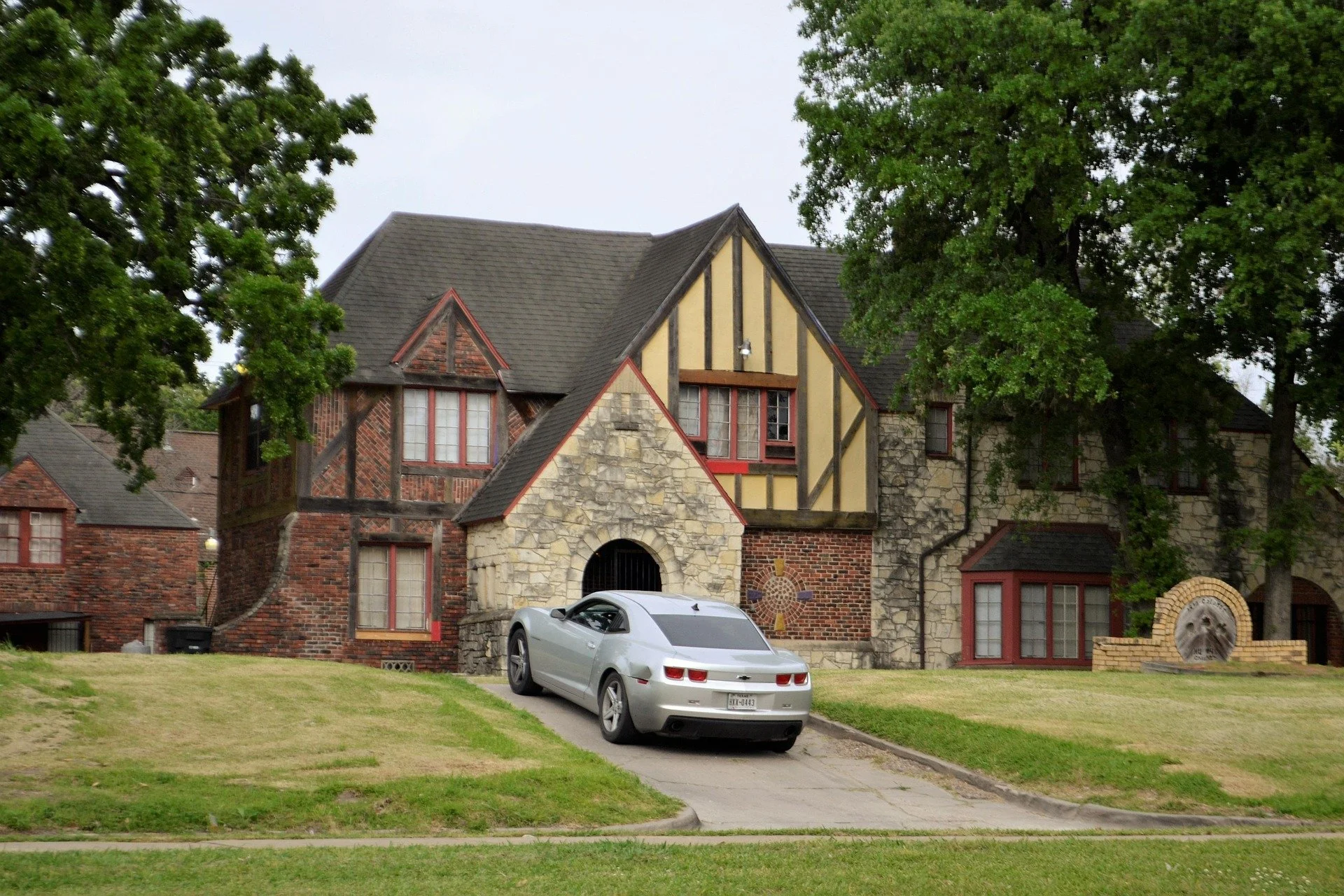NEWSLETTER - OCTOBER 2025
Current Topics:
Expert Tip of the Month
Both Houston buyers and sellers can gain an edge this fall by acting early, prioritizing transparency, and presenting homes in top condition to leverage slower seasonal activity and motivated counterparts.
As Houston moves deeper into fall 2025, sellers and buyers alike can gain a competitive edge by focusing on three interlinked levers: timing, transparency, and home condition. First, timing matters: while summer often brings peak activity, early fall traditionally sees a modest slowdown. Inventory tends to rise and buyer urgency can dip as families settle children into school and vacations wind down. For sellers, this means listings may stay on market longer, so getting ahead by preparing early is essential. Scheduling professional staging, high-quality photography, and possibly virtual tours before mid-October can ensure your listing enters the market looking its best just as many buyers begin shopping more seriously. For buyers, recognizing that the fall may bring more motivated sellers is important; they may be more willing to negotiate than during peak months.
Second, transparency; both in listing and in negotiations, has become increasingly critical. Recent Houston data show that active inventory is elevated compared to earlier in 2025, and homes are lingering longer: the median days on market for home sales in Houston in August was 47 days, up from about 39 days one year ago (Redfin). Buyers are using that leverage to dig deeper into disclosures, inspection reports, and seller history. Sellers who provide full inspection reports upfront or are clear about needed repairs tend to build trust and avoid later renegotiation or fall-throughs. Buyers who come prepared with financing in order or pre-approvals are better positioned to close quickly, which is an advantage when multiple offers begin to appear even in slower months.
Third, focus on the condition and presentation of the home. Even modest enhancements—fresh paint, landscaping, small upgrades to kitchens or baths, decluttering; can make a difference. As luxury and upper-end homes in neighborhoods like River Oaks, Piney Point, and Tanglewood continue to command attention (with million-dollar-plus homes seeing nearly 13% growth in sales in August) for their prestige and amenities, the contrast widens for more modest homes (Houston Chronicle). For entry and mid-tier segments, buyers expect clean, move-in ready features and transparent documentation of maintenance. Homes that appear “list-ready” tend to get better offers sooner, especially once winter approaches and buyer activity drops further.
In sum, sellers should list now with polished homes, accurate disclosures, and professional marketing to maximize their window of opportunity; buyers should lean into this season, use due diligence, insist on transparency, and look for sellers motivated by time more than price. Both sides benefit from understanding where the balance of power has shifted in Houston’s real estate market, and acting accordingly.
Market Overview:
September Snapshot
Houston’s housing market shows steady price growth but slower sales, longer market times, and higher inventory, giving buyers more leverage while sellers who price strategically and maintain well-presented homes can still achieve strong results.
As of August 2025 in Houston (the most recent complete data available as of late September), the housing market presents a picture of steady price growth but also signs of moderation in speed, increasing inventory, and growing buyer power. Let’s dive into the numbers. The median sale price for homes in Houston rose to $355,000, a 7.6% year-over-year increase from August 2024 (Redfin). Meanwhile, the number of homes sold climbed modestly: 1,694 homes sold in August 2025, up about 3.5% over August 2024’s 1,637 homes (Redfin) .One key indicator of shifting market pace is the days on market: the median home took 47 days to sell in August 2025, compared to around 39 days in the same period last year; an increase of about eight days. That suggests buyers are taking more time, and sellers may need to be more patient or more aggressive in pricing (Redfin).
On the supply side, inventory is higher. Active listings (single family homes and condominium/townhouse types) have risen, giving buyers more options. The greater Houston‐The Woodlands-Sugar Land metro area is showing inventory levels in the mid-30,000s of active listings. While exact mid-September data isn’t yet published, August and earlier months show that’s above what was typical in early 2025 (FRED). Simultaneously, median price per square foot remains robust: around $179/sq ft for all home types, though down about 1.1% year-over-year in that metric—suggesting that overall price growth is dragging a little on per-foot value (Redfin).
Other snapshots: the luxury market continues to perform well. Homes over $1 million in inventory and sales are drawing interest, especially in neighborhoods known for prestige and amenities such as River Oaks, Piney Point, and Tanglewood (Houston Chronicle). On the rental side, average apartment rent in Houston climbed to roughly $1,360/month in August 2025, with apartment unit size averaging about 883 square feet (RentCafe). Also, demand remains strong for single-family rentals, as many households face affordability constraints in purchasing a home (myneighborhoodnews.com).
In summary, September’s data (primarily reflecting August) suggests Houston is still appreciating, but the pace is moderating. Homes are spending longer on market, inventory is growing, especially in middle and upper price tiers, while luxury segments are holding steadier. Buyers are gaining incremental influence, but sellers who adjust strategy and presentation can still find favorable outcomes.
Buying Trends:
Houston Buyers This Fall: Cautious and Strategic
This fall, Houston buyers are more selective, financially prepared, and willing to compromise on location, size, and amenities, using technology and market insights to negotiate smarter and target favorable timing.
Buyers in Houston this fall are behaving distinctly: they are more cautious, better informed, and selective. With home prices up (7.6% YoY) and the median days on market stretching to 47 days, many buyers are shifting strategy; moving slower, demanding more information, negotiating harder, and considering neighborhoods they may have passed over in prior years (Redfin). One big trend: broader tolerance for trade-offs. Location vs. amenities, smaller lot size vs. updated features, proximity to schools vs. commute time; many buyers are more willing to compromise than during recent tighter, seller-favoring markets.
Another major shift is toward single-family homes in suburban or fringe areas. Demand for space remains high—buying options with more indoor and outdoor space are appealing, especially as remote or hybrid work continues to influence lifestyle. As some parts of the city center become expensive or less spacious, suburbs like Cypress, Katy, Pearland, and Richmond are seeing more interest. These areas typically offer newer stock, amenities, more land, and lower per-square-foot prices. Builders and developers are responding, especially with more build-to-rent or suburban single-family inventory. (HAR.com)
Financial readiness is more crucial than ever. With mortgage rates remaining elevated and price per square foot creeping up (though slightly or flat in some segments), buyers with strong credit, good down payments, and pre-approval are achieving better outcomes. Some are capitalizing on homes that have been listed 60+ days or that already have price reductions, thinking about long negotiation cycles, and available seller concessions. Buyers also seem to be more attuned to total cost; not just mortgage payments but taxes, insurance (especially in flood zones), maintenance, and utility costs. The Kinder Institute’s 2025 State of Housing report flags affordability, rising insurance costs, and climate related vulnerabilities as important (Kinder Institute).
Technology and transparency are enabling buyers to act smarter. Virtual tours, remote inspections, and detailed disclosure reports are more common. Other tools like price history, comparing days on market, seeing how many times an owner has reduced price, and studying neighborhood school, environmental, and risk factors (flood / heat / air quality) are increasingly part of buyer decision-making. Neighborhood safety data, for example, shows variation: violent crime in Houston is down ~14.3% year-to-date compared with last year (April 2025 vs April 2024), while nonviolent crime is down about 8.5% (Apartment List).
Finally, timing strategy: many buyers are watching for periods of seasonal softness (later fall, early winter) when competition tends to drop but inventory remains. Realtor.com has identified October 12-18, 2025 as a potentially good week nationally for buyers, with an opportunity to save, get more negotiable sellers, and lower competition. While local conditions vary, Houston buyers may find that mid-October offers some strategic advantages (Better Homes & Gardens).
Selling Highlights:
Houston Sellers: Smart Strategy and Staging This Fall
This fall, Houston sellers can maximize results by pricing realistically, investing in home condition and presentation, leveraging professional marketing, and timing listings to attract motivated buyers.
Given the trends noted above, sellers need refined strategy rather than broad pricing alone. In many segments, overpricing is becoming a liability. As homes are staying on market longer (average ~47 days in August) and buyers are more price‐sensitive, listings that begin too high often face subsequent price reductions, which can deter buyer confidence (Redfin). Sellers who set realistic prices from the outset have better chances of attracting serious buyers and avoiding price cutting later, which often ends up costing more in perceived value.
Investments in home condition yield quite strong returns. Staging, both interior and exterior, helps; homes that show well tend to get more foot traffic, better photos, higher early interest. Small but visible upgrades (fresh paint, replaced hardware, clean or renovated kitchens and bathrooms, landscaping) are more visible now that buyers have more choices and are comparing listings more critically. Sellers should also consider neutralizing décor to appeal to the broader market, and investing in curb appeal; first impressions matter, particularly online.
Marketing strategy is another area where sellers who invest wisely are seeing outsized returns. Professional photography, drone or aerial shots (especially for larger lots), high-quality virtual tours, and good floor plans are no longer optional extras; they’re baseline expectations for many buyers. Listings that offer transparency (e.g. recent inspection reports, disclosures, flood risk, insurance cost) tend to attract more qualified leads, fewer surprises, and shorter closing cycles. Also, making homes available for showings with flexible timing; weekdays, evenings, weekends, increases exposure.
Seller’s concessions or incentives may be useful tools in negotiation. With rising mortgage rates and buyer affordability tightening, offering buyer incentives; like help with closing costs, temporary interest rate buy-downs, or including some fixtures; can make an offer more attractive without dropping list price drastically. Pricing may also reflect structure, e.g. listing at a slightly lower price to drive competition, especially in well-priced comparable neighborhoods.
Luxury and prestige markets in Houston are still strong. Properties above $1 million in neighborhoods such as River Oaks, Piney Point, Tanglewood, waterfront Galveston, etc., remain destinations for buyers seeking lifestyle, architecture, views, and amenities. High-end finishes, custom design, and rare or iconic elements help luxury listings shine even as broader market segments moderate (Houston Chronicle).
Lastly, timing is essential. While listing in mid-fall can mean somewhat less buyer traffic than summer, it also means less competition and more serious buyers. Buyers who have lagged behind during the peak season often re-emerge, motivated by lower interest rates or end-of-year tax or financing triggers. For sellers, being ready with all documentation, staging, repairs, and pricing early in October rather than waiting until holiday season is generally advisable.
Rental Market Update:
Houston Rentals: Steady Growth and Suburban Demand
In mid-2025, Houston’s rental market shows moderate growth with rising demand for single-family homes in suburbs, stable occupancy, and renters prioritizing space, amenities, and location while negotiating incentives where available.
Houston’s rental market in mid-2025 demonstrates steady, moderate growth, shifting preferences, and widening gaps between unit types and locations. The average rent for an apartment; across all unit types, was approximately $1,360/month in August 2025, for units averaging about 883 square feet (RentCafe). That trend is slightly upward versus a year prior, though growth is more muted than during peak inflationary rent periods. Some reports indicate average rent closer to $1,475/month in Q2 2025, up ~4.8% YOY, reflecting demand for more amenity-rich or better located units (Advantage Asset Management).
One standout feature is the surge in demand for single-family rentals. Many households that are unable or unwilling to purchase are opting for rentals that deliver more space, yards, driveways, and privacy. In fact, rental supply of single-family homes in Houston hit record numbers in mid-2025, particularly in suburbs. For example, Cypress has been highlighted as building over 1,000 single-family rental units this year, with the broader metro building thousands of such units as build-to-rent becomes a growth sector (CultureMap Houston). Townhouses and condos are growing more slowly; their leasing activity has slackened in some instances, possibly because renters prioritize larger space and quieter or more suburban settings over proximity to urban cores (myneighborhoodnews.com).
Vacancy rates remain relatively stable, and occupancy levels are predicted to hold around 90-91% for much of 2025, according to several forecasts (MMG Real Estate Advisors). But the new supply of built units (especially multi-family) has slowed somewhat. Developers are pulling back somewhat, partly due to high interest rates, cost of materials, and margins being squeezed (Houston Chronicle). As supply growth slows while demand remains steady (especially for single-family rentals), we may see more upward pressure on rents, especially in suburbs or in areas where newer listings are limited.
Another dimension is location and amenities: renters are showing preference for communities that offer good school zones, lower traffic or commute times, green space, decent air quality, and lower risks from flooding. In inner-city or near-downtown areas, where older units dominate, rents are higher but so are trade-offs (noise, parking, maintenance). Suburbs with build-to-rent and newer construction are winning favor, particularly among families and households with remote or hybrid work arrangements. Amenities such as private outdoor space, home office potential, high-speed internet, garages, and pet-friendly features are increasingly being factored in.
Finally, incentives are still playing a role. Some landlords in multi-family complexes or newer developments are offering concessions such as first month free, waived pet or move-in fees, or included utilities; especially in less central or oversupplied neighborhoods. For renters, autumn can be a favorable time to negotiate. For investors or landlords, pay attention to maintenance costs, insurance (particularly flood or disaster risk), local property taxes, and long-term occupancy trends; over-investing in units without desirable features may lead to longer vacancy periods or demands for higher concessions.
Neighborhood Spotlight:
The Heights: Houston’s Charming, Walkable, and Hot Market
In October 2025, The Heights continues to attract buyers and renters seeking character, walkability, and proximity to central Houston, with stable home values, strong rental demand, and opportunities for renovated or infill properties.
For this October edition, we turn our spotlight to The Heights / Greater Heights area of Houston; a neighborhood historically prized for its tree-lined streets, bungalow and cottage architecture, walkability, and proximity to central Houston. With changing market dynamics, the Heights area offers a revealing case of how middle to upper-middle neighborhoods are adapting in 2025.
Firstly, home values in the Heights remain among Houston’s more stable and strong performers. While city-wide median sale price in August was $355,000, homes in the Heights typically sell for significantly more than that baseline, particularly for larger lots or homes with historic character. Buyers seeking charm, character, and location are willing to pay premiums. Meanwhile, per-square foot price statistics show that homes in these neighborhoods hold their value well because buyers value craftsmanship, established trees, walkability, architectural style, and community amenities. The trade-off is sometimes smaller lot sizes or less modern “new-build” flashy finishes compared with suburb‐newer construction, but many buyers are embracing these trade-offs for lifestyle.
Days on market in Heights and similar central neighborhoods may be less than the city median, especially for well-maintained homes with desirable features; buyers expect to pay more but also expect fewer compromises on location, walkability, aesthetic detail, and neighborhood feel. We’re seeing that homes in the higher prestige segments (examples: River Oaks, Piney Point, Tanglewood) continue to command strong attention; neighbors like Heights sit just below them in many buyers’ consideration sets; offering much of what those prestige areas offer, minus perhaps expansive acreage or waterfront (Houston Chronicle).
Rental demand in the Heights area is also noteworthy. Units in neighborhoods like Greater Heights, Lazy Brook, Montrose (not far off), Washington Avenue / Memorial Park, and similar areas post higher rent averages (often well above the Houston average of ~$1,360) for smaller units, due to proximity to central destinations, walkability, lifestyle amenities, nightlife, green spaces (RentCafe). Renters who prioritize locations with strong public transit or proximity to work centers (Medical Center, downtown) often accept smaller square footage in order to be in the Heights or similar neighborhoods. Thus, heightening demand pressures there for well-maintained, renovated older homes and for infill/new construction that respects neighborhood character.
One interesting evolving dynamic is renovation vs new build. Many older homes are being renovated, updated inside while keeping their historic façade, original charm, etc., to appeal to modern buyers who want both style and functionality. Also infill lots are being developed. However construction costs, zoning, lot size limitations, and preservation of neighborhood character can push costs up. Buyers and sellers in this area need to be conscious of insurance (especially flood risk in some parts), property taxes, and HOA or community association restrictions (where present). The Heights is culturally rich, which draws value, but buyers also often pay for what are sometimes underlying risks (older infrastructure, high repair costs).
Looking forward, The Heights is positioned well. As more buyers seek quality of life, walkability, and proximity rather than purely square footage, neighborhoods like Heights are increasingly competitive. Sellers who maintain the charm and modernize in key areas (kitchens, baths, energy efficiency) are likely to see strong interest. Buyers who are willing to compromise on some size or accept renovation may find excellent value here versus suburbs when factoring in commuting, amenities, and long-term livability.
Local Insight:
Navigating Climate Risks, Affordability, and Community Resilience
Houston buyers and renters in 2025 are weighing climate risks, affordability pressures, and neighborhood resilience alongside amenities and safety, making environmental and infrastructure factors increasingly critical in real estate decisions.
Houston’s real estate dynamics cannot be understood outside of its intersections with climate risk, affordability challenges, infrastructure, and community resilience. Recent research from the Kinder Institute for Urban Research highlights that more than half a million residents in Harris County and Houston live in neighborhoods simultaneously facing high risks of flooding, extreme heat, and poor air quality (Kinder Institute). These environmental pressures are increasingly material to property value, insurance cost, habitability, and buyer / renter decision making.
Affordability remains a core concern. As housing costs (purchase price, property taxes, insurance) rise, many households are squeezed; especially in light of rising costs of insurance in flood-prone areas, higher premiums related to climate risk, and the energy costs tied to a hotter climate. The cost of homeownership has increased not just via price, but also via financing (interest rates), insurance, and maintenance. Renters too face affordability pressure: average rents are rising, utility costs are higher, and the quality / amenities differential between older vs. newer rental stock is more significant. Policies and programs at city, county, and state levels are increasingly focused on assisting first-time homebuyers, flood mitigation, and resilience to heat and climate conditions.
Infrastructure and community resilience are also becoming part of the conversation among buyers, renters, and local governments. Drainage, flood plain maps, stormwater improvements have growing importance. Some areas formerly thought safe are being reclassified or seeing changes in required flood insurance. Developers are paying more attention to elevation, foundation, materials, and siting with respect to flood risk and storm surge. Neighborhoods with strong elevation, good drainage infrastructure, and proactive city planning are better insulated against downside risks—and that resilience increasingly matters to serious buyers and lenders.
Another local insight: the effect of policy and development patterns. Houston’s strong economic base (energy, medical research, port, aerospace, manufacturing) continues to attract migration, fueling housing demand. However, regulatory, zoning, building permit, and environmental policy challenges (e.g., permitting delays, flood plain regulation, insurance underwriting) can slow new supply. The slowdown in apartment / multifamily construction in 2025 (with Houston delivering fewer new apartment units than expected, and developers pulling back due to high costs) is likely partly tied to these constraints (Houston Chronicle). Additionally, programs for affordable housing, down payment assistance, and innovations like 3D-printed homes (as in Zuri Gardens near Hobby Airport) are gaining traction, offering alternative paths to homeownership with cost and time savings (Houston Chronicle).
Local culture and amenities still play a key role: proximity to good schools, transit, green space, walkability, parks, arts and cultural assets are increasingly factored into buyer and renter decisions. As buyers become more selective, those neighborhoods that deliver more than just four walls are gaining premium—those that combine safety, community, convenience, and environmental resilience are winning. For example, safety metrics show that violent crime in Houston dropped ~14.3% year-to-date versus the previous year (April 2025 vs April 2024), and nonviolent crime dropped ~8.5% (Apartment List).
Finally, insurance and costs tied to climate (flood insurance, wildfire risk, utility bills associated with cooling) are rising, and buyers/owners/renters need to build these into their cost calculations. Being near transit, green infrastructure, or elevated land may provide future protection and value retention. Local governments and stakeholder groups are increasingly promoting resilience, but for now many buyers/renters still under-price these risks.
Q & A:
Ask the Experts
Q: Is it better to list my home in the fall or wait until spring?
A: Listing in the fall can be a smart move; there’s typically less competition, buyers are more serious, and a well-prepared home can stand out, often leading to quicker sales and strong offers.
Looking Ahead:
October & Beyond
As Houston heads into October 2025, buyers and sellers should navigate moderating price growth, rising inventory, and affordability pressures by strategically timing moves, monitoring listings, and factoring in neighborhood amenities and climate-related risks.
As we move into October 2025 and toward year-end, Houston’s real estate market appears at a pivotal moment. Several indicators suggest a gradual shift: price growth remains positive but moderating, inventory is up, days on market rising, and affordability pressures are mounting. For both buyers and sellers, positioning now; both operationally and strategically, will matter significantly for outcomes in late 2025 and into 2026.
Here are what to watch and some strategic recommendations:
Interest Rates & Mortgage Environment: Rates have been elevated, which increases monthly payments and reduces buyer purchasing power. Even small movement up or down in interest rates can affect monthly affordability significantly. Buyers should lock in good rates when possible, and sellers should understand what comparable homes are priced at given current financing costs. National reports suggest that mid-October (especially the week of October 12-18) may be a favorable window for buyers with lower competition and possibly slightly better pricing (Better Homes & Gardens).
Inventory & New Listings: As inventory stays elevated, particularly in mid and upper segments, buyers will have more choice; but the market is unlikely to flood, because supply growth (especially in multifamily/apartment construction) is slowing. Developers are projected to complete fewer new multifamily units in Houston in 2025 vs earlier expectations (Houston Chronicle). Sellers should monitor new listings in their neighborhood to understand local competition; pricing just below new competition may help.
Price Reductions & Concessions: Expect more listings to face price reductions and more negotiated terms. Buyers should look for listings that have been on market for 30-60+ days as likely candidates for deals. Sellers should be open to incentives; closing cost assistance, upgrades, flexibility in inspection or move-in dates, that may make a sale smoother, especially if the property sits unsold for several weeks.
Suburb & Build-to-Rent Momentum: Suburban areas will continue to draw interest. Build-to-rent single-family home developments are being planned or built in substantial numbers, particularly in areas like Cypress, Katy, and outlying suburbs. These will appeal to renters and buyers who want space, yard, parking, or more affordable per-square-foot cost compared with central neighborhoods (CultureMap Houston).
Regulatory, Environmental, and Resilience Risks: Flood risk, insurance costs, and climate resilience are rising concerns. Buyers and renters need to factor these into purchase, financing, and negotiation. Sellers who invest in resiliency features (drainage, elevation, waterproofing, cooling efficiency) may find that these deliver more value than cost in certain neighborhoods. City and county policies around flood mitigation, building code upgrades, and climate risk disclosure may evolve, which could shift buyer preferences and cost structures.
Neighborhood Differentiation & Amenities: Neighborhoods that offer walkability, green space, good school access, transit, lower flood risk, safety, and cultural amenities will likely outperform. Central neighborhoods, Heights, Memorial, Washington Avenue / Memorial Park, etc., may see steeper competition in certain well-preserved homes. Suburbs that are well-connected or have good infrastructure may see increased demand.









